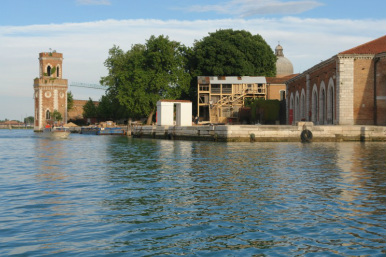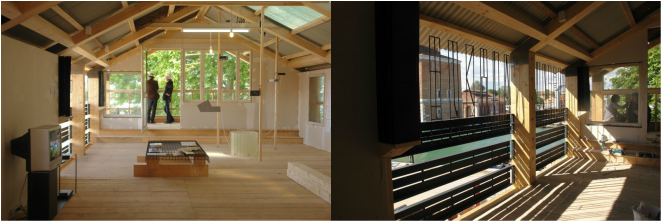“Kamikaze Loggia” is both a sculptural and an architectural installation. The team that worked alongside the artist, Gio Sumbadze, used a variety of basic construction materials – wood, dry wall, steel, tin/aluminum, etc. Throughout the installation, electrical wire was installed, connecting to lights, radios and televisions. Papers and photographs were attached to the walls. All of these additional details to the installation made the Loggia seem more “livable”. Size and location play an important role in the context of this installation. It has to be large enough to be inhabitable and must be an addition to an existing building. However, aside from being an artistic installation, this extension onto an existing building has been created since the 1990s as an unrefined reaction to the new, “lawless” era after the fall of the Soviet Union. These spaces create more living space and are typically used as terraces, extra rooms, open refrigerators, or—as in Sumbadze’s case—an artist studio.
“The exhibition looks at the creation of such informal architecture, a manifestation of the refusal of dominant structures, in order to incorporate provisional liberty, local self-determination and contemporary appropriation of the infrastructural legacy of Soviet master plans” [press release]

This installation is clearly in response to the historical laws that the Soviet Union placed on the “loggia” concept. With this new modern freedom, comes an installation to represent that architectural liberty. The elements of line, shape, space and time are used as dialogue in this installation. Lines are created by the steel sculpture that serves as a window decoration in this space, while it also creates shapes that incorporate the artistic elements of this installation (take notice of the AWESOME shadows and highlights in the picture above where the sunlight is shining through these steel window coverings...more pattern and repetition!) These shapes create pattern and repetition, which capture the viewer and contrast with the solid wood that surrounds the relatively vacant space. The lack of furnishings and objects in the space was a significant design choice. The artist wants the viewer to focus on the structure/space itself and its historical significance, as oppose to the objects or furnishings that may fill it. Harmony is created between the installation and the existing building that it is built onto. The two structures are able to coexist despite the law that once restricted this plan.
It is not like me to pick a piece of artwork that is so political but I really did learn a lot through my research about this installation. It has way more depth to it than what may reach the eyes of most viewers. This installation captured my interest because of the beautiful architectural, interior design elements that I have such an appreciation for. The historical significance was an added bonus! I think this piece of work is very effective at conveying the message of liberty and modern structure. It also functions well as an art installation but incorporating the many design principles I mentioned above. I will be very VERY excited to see this installation in person and hope to learn even more about what contemporary art has to offer!



 RSS Feed
RSS Feed